| Photojournal
- 19 and 22 July 2006
A
Little Stint at Iona
|
On Wednesday the 19th
of July, I had just finished overeating (I was testing the food
at a new restaurant up the street...sadly, it was lacking, but
I had to try lots of different stuff) when I got a phone call
saying that there was a Little Stint at the Iona sewage treatment
ponds.
Now, as you probably
know, in the past I've gone birding at Iona for a short while,
or, as one might say, I've done a little stint at Iona. But I'd
never seen a Little Stint at Iona. Or anywhere else, for
that matter. Little Stints, it turns out, are small shorebirds
(peeps) that are pretty uncommon around here. The phone call was
an exciting development. I immediately went home for my camera
and headed out to the ponds.
When I got there, there
were probably a dozen or so birders gathered looking at a rather
large collection of small shorebirds. Unfortunately, there was
just the one stint in the bunch, he didn't stand out that much,
and the birds didn't stay still too long. So I spend the waning
hours of the day looking through hundreds of very mobile small
birds for one special one. I didn't find it, and none of the birders
I was with saw it after I arrived (many had seen it before I got
there).
Well, I did take a
few photos of the fauna anyhow. Here's one of our usual small
shorebirds, a Least Sandpiper. Little Stints are pretty much the
same size and shape as this fellow, but with black legs and slightly
different markings on the body.
|
|
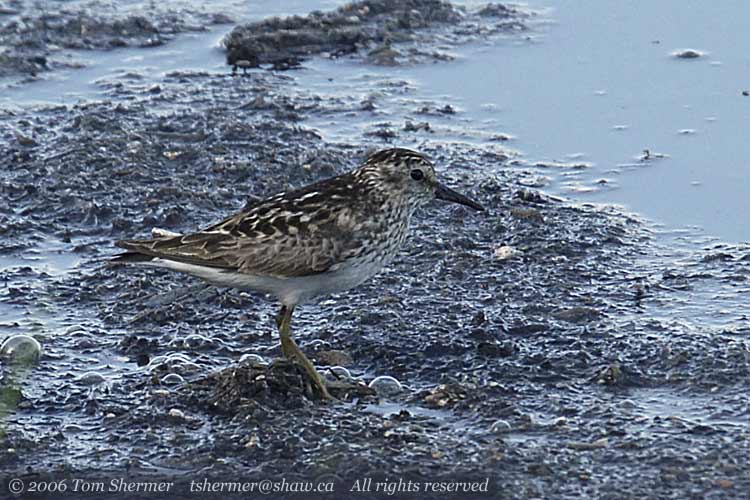 |
|
To me, that photo points
out how good the camouflage of these little pipers really is...the
bird gets a bit lost in the background.
Most of the birds out
on the pond that day were Western Sandpipers, which are also of
a similar size and shape to Leasts.
|
|
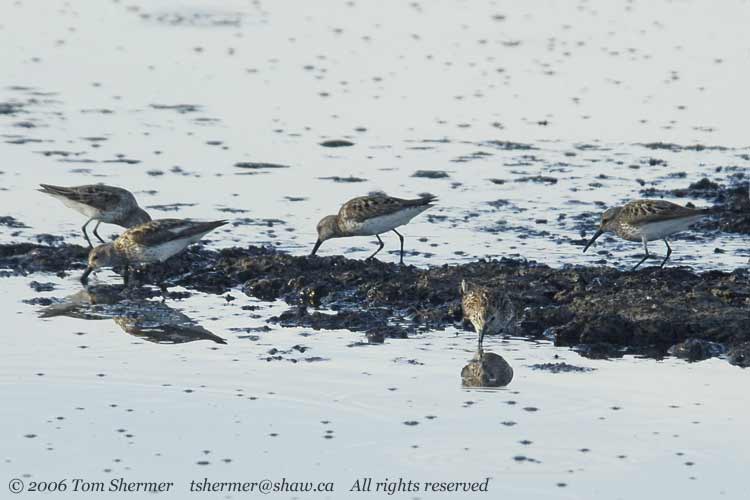 |
| Here are
a few more shots of Westerns...this one showing one coming in for
a landing. |
|
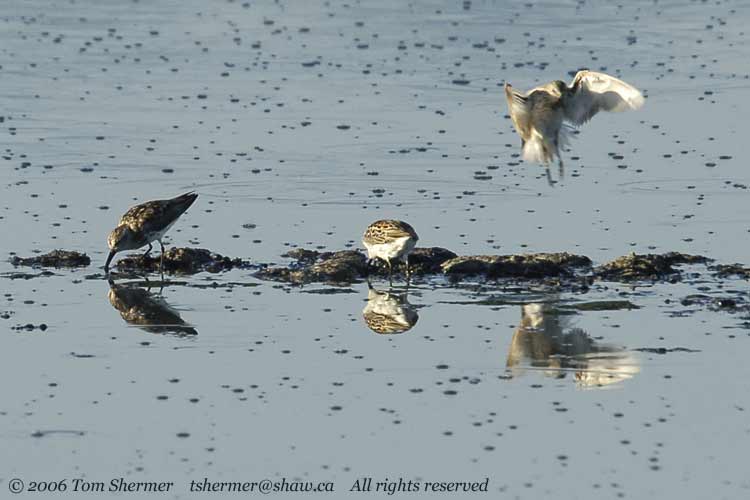 |
| And this
one showing more of a close-up. Here you can see some of the Western's
reddish-brown color. |
|
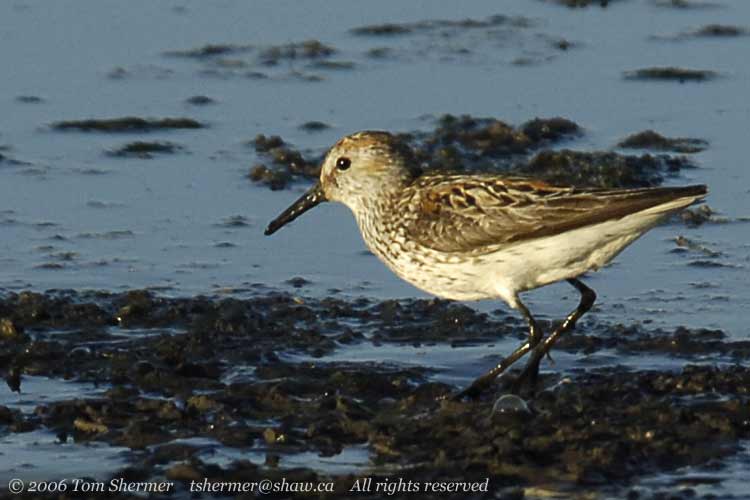 |
| One of the
few other birds at the pond was this Lesser Yellowlegs. I really
liked the color of the water around the bird, and the look of all
the little bubbles in it. |
|
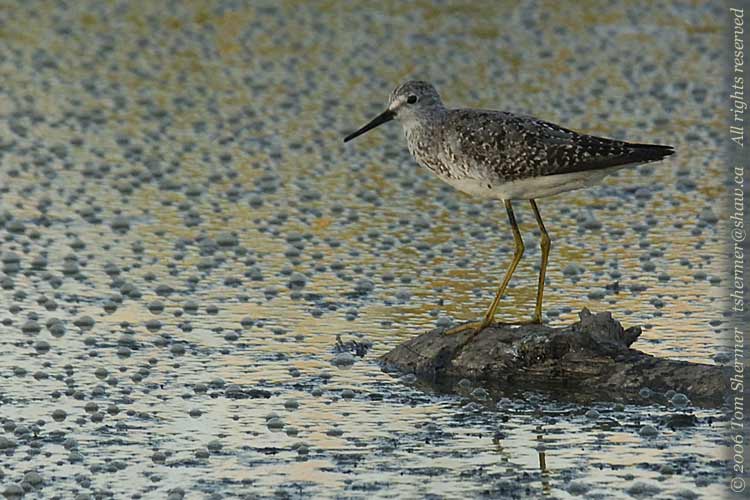 |
|
That was pretty much
it from Wednesday. I had spent most of my time looking through
binoculars for the stint, and the sun was down before I knew it.
The stint was spotted
for a day or two after that, but I was busy with work and not
able to make it out there. The next time I did make it out was
on Saturday the 22nd. Saturday started the way Wednesday had ended—with
a Lesser Yellowlegs.
|
|
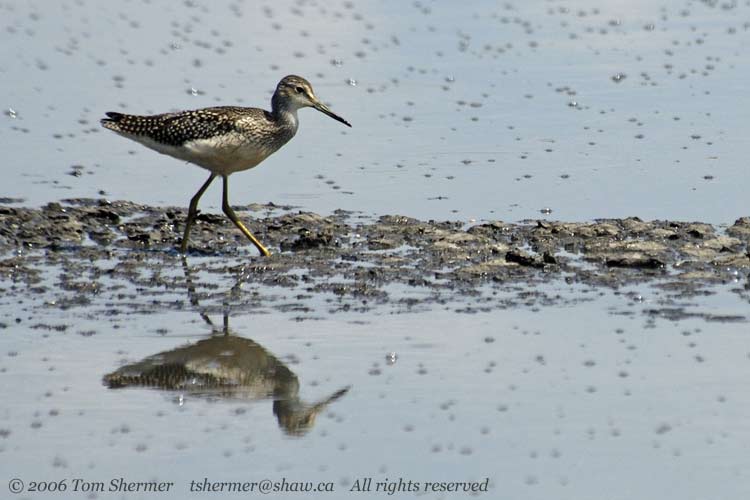 |
|
I hung around the inner
ponds for about an hour, meeting and chatting with a couple from
Seattle who had come up to try to see the bird. The whole time
we were there we saw only two or three small shorebirds; it was
quite a contrast from Wednesday.
So I gave up on the
Little Stint and headed on out to the outer ponds, in the public
part of the park. Soon after I got there, an Osprey flew over,
looking for lunch.
|
|
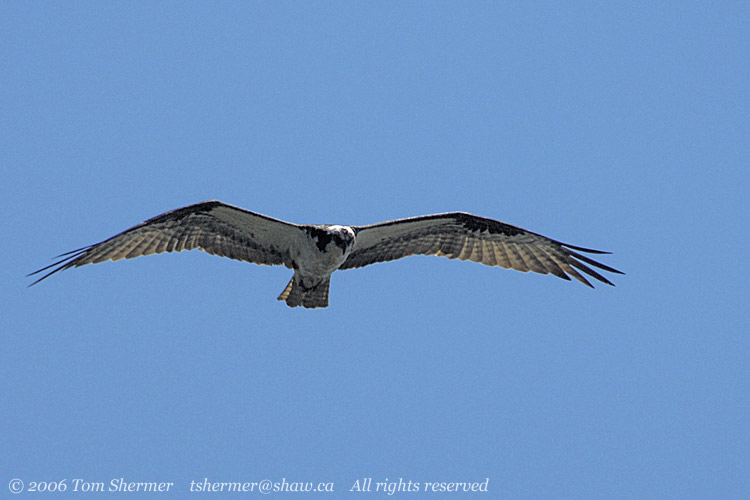 |
|
But other than that,
the birds were making themselves scarce. So despite not having
my macro lens with me, I decided to try to take some insect photos.
One of the things that's interesting at Iona is that near the
marshy north outer pond, there's generally lots of Western Sand
Wasps (Bembix americana). Sand Wasps have a very neat color
pattern: green eyes, yellow legs, and alternating light green
and black bands on the abdomen. Sometimes the light green looks
light blue.
Anyhow, here's one
of the little beauties now.
|
|
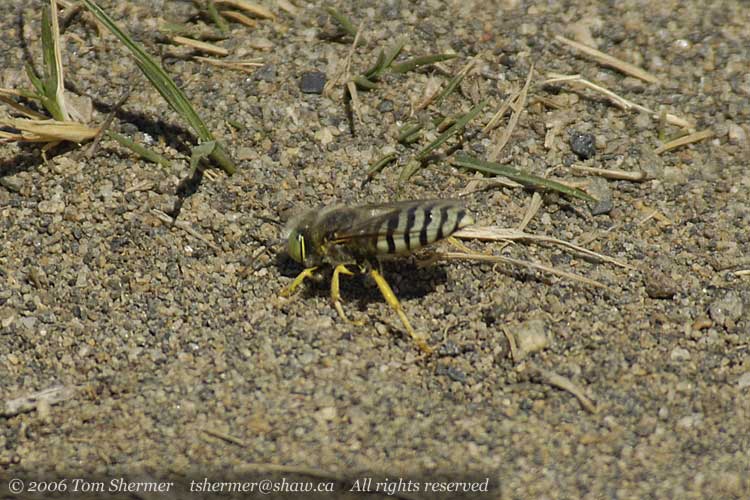 |
| Western
Sand Wasps are in the family Specidae, members of which are
commonly called Digger Wasps. With good reason, too: female Sand
Wasps dig long (40-50cm) burrows in the ground, where they raise
their babies. I found several of them digging, and stopped to watch
and photograph this one...you can see the sand flying out under
her tail end. |
|
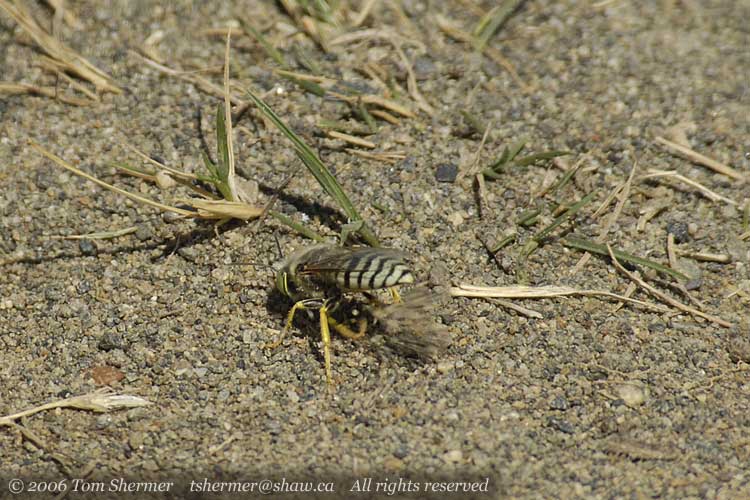 |
|
That was neat to see,
but I sure hoped that she had checked with the utilities commission
before she started that digging...there could be a power line
or something under there, and it's better safe than sorry.
I also caught a few
shots with two wasps interacting. I don't know what the interactions
were all about, but in the one shown below, the upper wasp just
came by and touched the lower wasp a bit with their legs, then
flew off. The lower one then went on digging, like nothing had
happened.
|
|
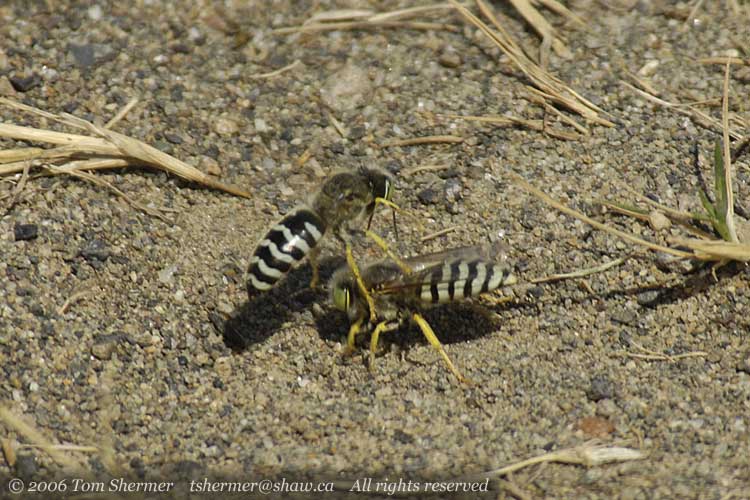 |
|
The ways of wasps can
be mighty mysterious.
Anyhow, I really dug
what the wasps were doing and one day I'll probably go back with
my macro lens and see if I can get any good close-ups of them.
Soon the midday sun
was starting to get to me, and so I headed back for my car. On
the way, I spotted this moth in some debris on the ground. I don't
know the species, and I've never had good luck trying to identify
brown moths.
|
|
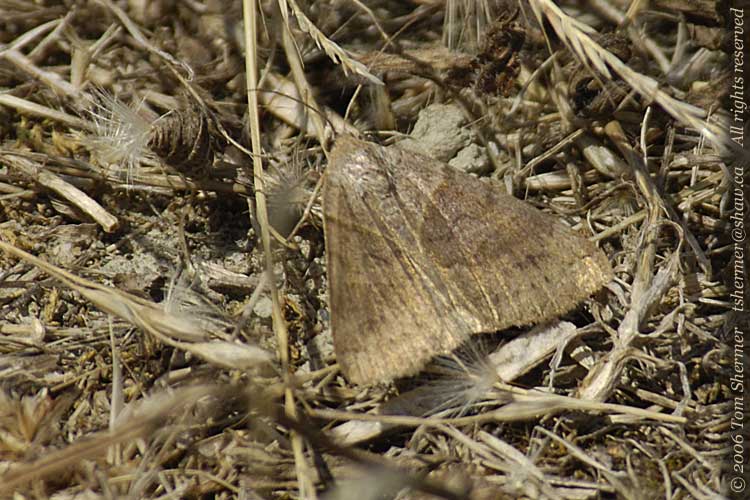 |
|
Right near the parking
lot, I found a place where there were a bunch of dragonflies patrolling
back and forth, going one way against the wind and the other way
with it. I got on their sunward side and tried to get shots of
them flying. It was really tough going, as autofocus wasn't fast
enough and I had to follow the dragons while trying to manuallyfocus...and
dragonflies tend to move fast and make sudden changes of direction.
It was frustrating,
but I thought it was good practice for me. Eventually I did get
a couple of shots of them in decent focus.
|
|
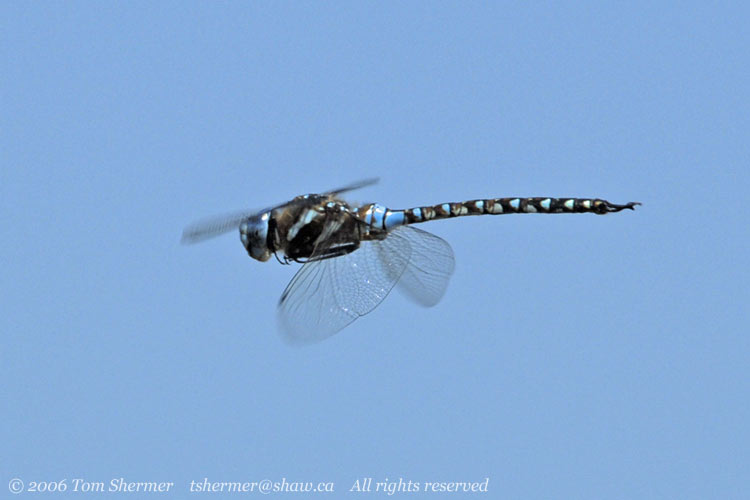 |
| Dragonflies
with this general shape are called darners, and ones with
the "tile-like" markings on their abdomen (tail) are called
mosaic darners. There are many types of mosaic darners, most
of them fairly difficult to tell apart. However, I think that the
pictures show enough for me to conclude that these were of the species
known as Blue-eyed Darners. |
|
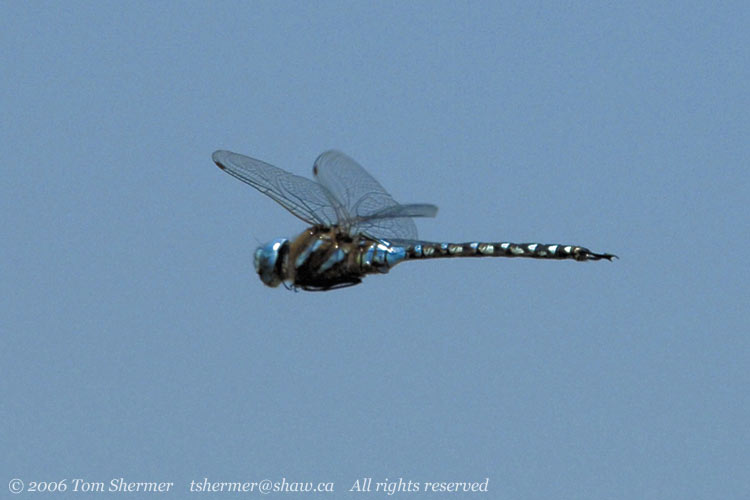 |
|
After fifteen minutes
or so with the darners, I retreated to the air-conditioned interior
of my car and spent the rest of my day on domestic errands.
Well, I've been darned.
Tom
|
|
|